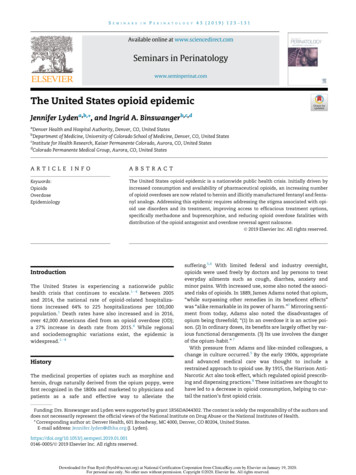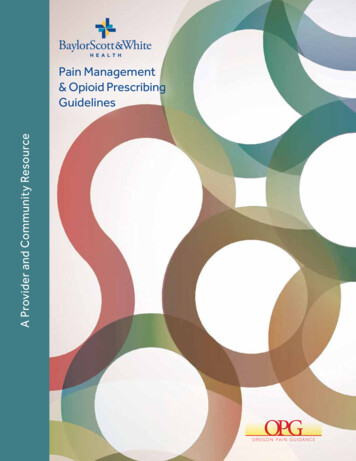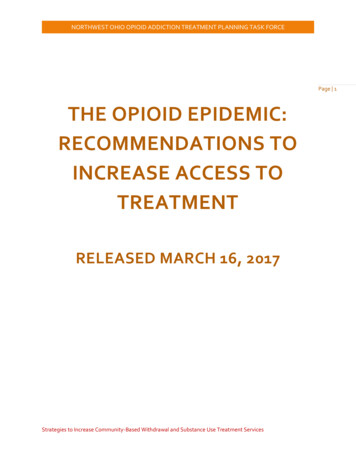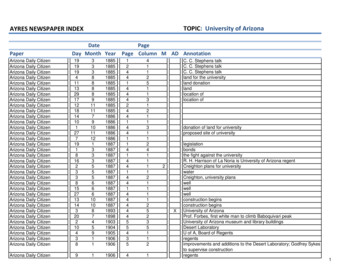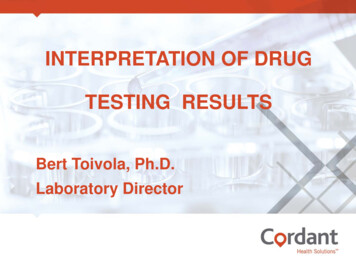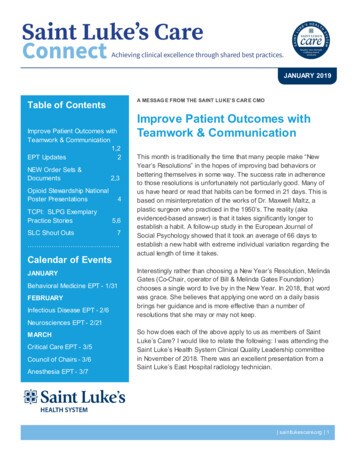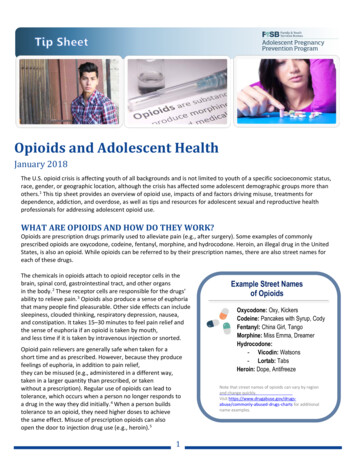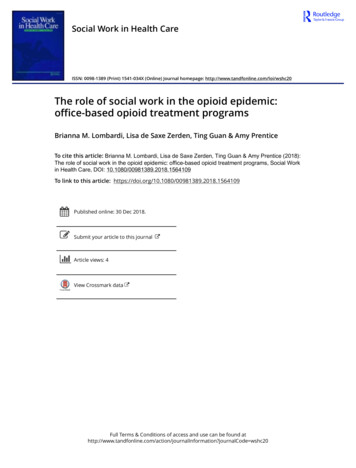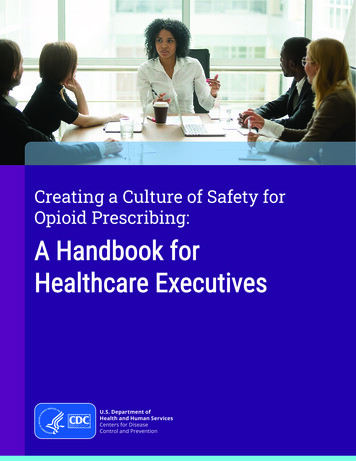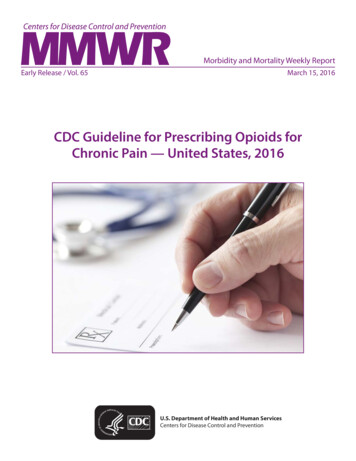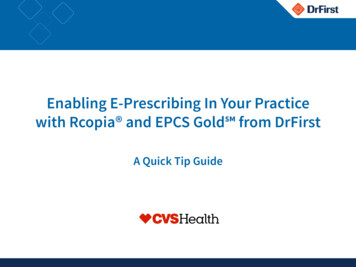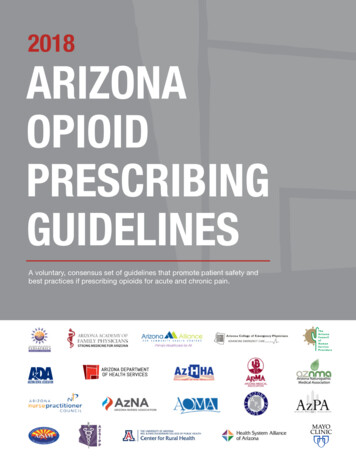
Transcription
2018ARIZONAOPIOIDPRESCRIBINGGUIDELINESA voluntary, consensus set of guidelines that promote patient safety andbest practices if prescribing opioids for acute and chronic pain.
azhealth.gov/opioidDISCLAIMERThis document should not be used to establish any standard of care or any deviation or variance from an accepted standard of care; nor should it be used solely to establish any health insurancecoverage or determination. No legal proceeding, including medical malpractice proceedings or disciplinary hearings, should reference a deviation or variance from any part of this document as evidenceof a breach of professional conduct, health insurance coverage policy or determination, or evidence that a deviation or variance from any part of this document demonstrates negligence, misconduct,errors or omissions, or breach of contract in the rendering of health care. These voluntary guidelines are an educational tool for providers, meant to promote informed management of Arizonans withacute and chronic pain. Clinicians should use their own independent clinical judgment and consider but not base clinical decisions solely on this document.The following guidelines are founded on the best available evidence, national guidance, and Arizona-specific data on opioid overdoses.1
SUMMARY GUIDELINES FOR THE TREATMENT OF ACUTE AND CHRONIC PAINThere are more than two Arizonans dying every day from an opioid overdose, and the majority of deaths are due to prescriptionopioids. It is imperative that Arizona clinicians have prescribing practices that maintain safety for their patients and community,while also addressing their patients’ pain.The following seventeen guidelines for non-cancer, non-terminal pain are designed to provide information and assist decisionmaking for providers. Each patient and clinical presentation is unique, however, and these statements must not supersede medicaljudgment and risk-benefit analyses.ACUTE PAIN1 Use non-opioid medications and therapies as first-line treatment for mild and moderate acute pain.2If opioids are indicated for acute pain, initiate therapy at the lowest effective dose for no longer than a 3-5 day duration;reassess if pain persists beyond the anticipated duration.3 Do not use long-acting opioids for the treatment of acute pain.CHRONIC PAIN4Prescribe self-management strategies, non-pharmacologic treatments and non-opioid medications as thepreferred treatment for chronic pain.5 Do not initiate long-term opioid therapy for most patients with chronic pain.6Coordinate interdisciplinary care for patients with high-impact chronic pain to address pain, substanceuse disorders and behavioral health conditions.RISK MITIGATION7For patients on long-term opioid therapy, document informed consent which includes the risks of opioid use, optionsfor alternative therapies and therapeutic boundaries.8 Do not use long-term opioid therapy in patients with untreated substance use disorders.9Avoid concurrent use of opioids and benzodiazepines. If patients are currently prescribed both agents, evaluate taperingor an exit strategy for one or both medications.10Check the Arizona Controlled Substances Prescription Monitoring Program before initiating an opioid or benzodiazepine,and then at least quarterly.11Discuss reproductive plans and the risk of neonatal abstinence syndrome and other adverse neonatal outcomes priorto prescribing opioids to women of reproductive age.12If opioids are used to treat chronic pain, prescribe at the lowest possible dose and for the shortest possible time.Reassess the treatment regimen if prescribing doses 50 MEDs.13Counsel patients who are taking opioids on safety, including safe storage and disposal of medications, not driving ifsedated or confused while using opioids and not sharing opioids with others.14Reevaluate patients on long-term opioid therapy at least every 90 days for functional improvements, substance use,high-risk behaviors and psychiatric comorbidities through face-to-face visits, PDMP checks and urine drug tests.15Assess patients on long-term opioid therapy on a regular basis for opioid use disorder and offer or arrange formedication-assisted therapy (e.g. methadone and buprenorphine) to those diagnosed.16 Offer naloxone and provide overdose education for all patients at risk for opioid overdose.17Individualize a careful exit strategy from the use of long-term opioid therapy for chronic pain, when indicated by arisk assessment.2
TABLE OFCONTENTSDisclaimer1Purpose of the Guidelines4Updates to the Guidelines4Intended Audience and Scope4Glossary of Terms5Summary Guidelines for the Treatment of Acute and Chronic Pain6Elaborated Guidelines for the Treatment of Acute and Chronic Pain8Appendices16A: How to implement these guidelines into clinical flowB: How to manage an “inherited patient” on opioid therapyC: How to evaluate patients for opioid use disorderD: How to connect patients with medication-assisted treatmentE: How to approach an opioid exit strategyF: How to manage pain and opioids in special populationsG: How to connect with local and national resourcesH: How to correct clinical misperceptions about opioidsReferences42Acknowledgments473
PURPOSE OF THE GUIDELINESThe Centers for Disease Control and Prevention (CDC) has described an opioid epidemic in the United States. Overdoses involvingheroin, fentanyl and prescription opioids killed more than 33,000 people in the United States in 2015. Nearly half of those deathswere from prescription opioids.The Arizona Department of Health Services has found that more than two Arizonans die every day from an opioid overdose, themajority from prescription opioids. Prescription opioids are used routinely in Arizona, with over 205 million opioid pills prescribedbetween January and July 2017, enough for every resident to have a 30-pill supply. In addition to overdose fatalities, there aremany times those numbers of nonfatal opioid overdoses reported to the Department, along with daily reports of suspected neonatalabstinence syndrome.Prescribing practices have contributed to the current opioid crisis and a shift in prescribing culture, approach to pain and recognitionof substance use disorders is needed. The following Arizona Opioid Prescribing Guidelines aim to reduce overreliance on opioidtherapy, make safety a priority in managing acute and chronic pain, and increase awareness of treatment of opioid use disorder.These guidelines reflect the best available evidence and local data, and can assist in clinical decision-making for Arizona providers.It is recognized that access to recommended options may be limited by availability and affordability.UPDATES TO THE GUIDELINESThis is the second edition of the Arizona Opioid Prescribing Guidelines. One of the deliverables from the 2017 State of Public HealthEmergency, as declared by Arizona Governor Doug Ducey, was to update the 2014 guidelines for Arizona clinicians.Current updates reflect:1.Incorporation of the most recent evidence, national guidelines (including the VA/DoD Clinical Practice Guideline for OpioidTherapy for Chronic Pain, 2017 and CDC Guideline for Prescribing Opioids for Chronic Pain, 2016), best practices from otherstates and Arizona data. Most references are recent, and guided the inclusion of newer concepts such as “high-impact chronicpain,” “complex persistent opioid dependence” and “opioid exit strategies.”2.A shift in pain care that avoids unnecessary exposure to opioids in order to reduce the risk of adverse outcomes. Previousguidelines focused on the “safe prescribing” of opioid therapy, while these guidelines aim to prevent initiating unnecessaryopioid therapy while addressing patients’ pain from a whole-person perspective.3.Emphasis on nonstigmatizing language. Health care providers can counter stigma by using accurate, nonjudgmental language.These guidelines employ person-first language (“Patients with substance use disorder” instead of “addicts”), nonjudgmentalterminology (“negative urine drug test” instead of “dirty”) and supportive terms (“recovery” instead of “no cure”).4.Increased focus on prevention, recognition, and treatment of opioid use disorder in patients receiving long-term opioid therapyfor chronic pain, given the high risk of developing opioid use disorder in this population.5.Integration into clinical workflow (operationalization). A key element of success of guideline implementation is how seamlesslyit can be incorporated into a clinician’s normal activities. This revised version includes specific operationalization actions undereach guideline, and summarizes them in Appendix A. The tone is also purposely direct and actionable, rather than passive.INTENDED AUDIENCE AND SCOPEThe Arizona Opioid Prescribing Guidelines (2018) are intended for use by clinicians in primary care and outpatient settings whoprovide care to patients receiving treatment for acute and chronic pain that is not occurring at the end of life or after complex surgery,and is not due to an active malignancy.They may also be used by hospitals, outpatient surgical centers, behavioral health inpatient facilities and nursing care institutions forthe management of pain upon discharge.4
GLOSSARY OF TERMSACUTE PAIN: pain lasting less than 90 days.ADDICTION: a primary, chronic disease of brain reward, motivation, memory and related circuity. Dysfunction in these circuitsleads to characteristic biological, psychological, social and spiritual manifestations. Addiction is characterized by the inability toconsistently abstain, impairment in behavioral control, craving, diminished recognition of significant problems with one’s behaviorsand interpersonal relationships, and a dysfunctional emotional response.ARIZONA STATE BOARD OF PHARMACY CONTROLLED SUBSTANCES PRESCRIPTION MONITORING PROGRAM(AZ CSPMP): Arizona’s Prescription Drug Monitoring Program.BIOPSYCHOSOCIAL ASSESSMENT: a comprehensive assessment of co-occurring medical and psychiatric conditions, personal andfamily history of substance use disorder, functional status and functional goals, coping strategies, and psychosocial factors such asthe patient’s beliefs and expectations about chronic pain and its treatment.CDC: Centers for Disease Control and Prevention.CHRONIC PAIN: pain persisting longer than 3-6 months and beyond the normal tissue healing time.COMPLEX PERSISTENT OPIOID DEPENDENCE: the clinical and psychological state that exists on the continuum between simpleopioid dependence (which presents with short-lived and self-limited withdrawal symptoms after opioids are discontinued) and opioiduse disorder. Symptoms of complex persistent opioid dependence can include worsening pain, patient reported function, affectivesymptoms, sleep disturbance and other protracted withdrawal symptoms upon opioid dose reduction or cessation.FDA: Food and Drug Administration.HIGH IMPACT CHRONIC PAIN: chronic pain that is associated with substantial restriction of participation in work, social and selfcare activities for six months or more.INFORMED CONSENT: patient-centered information about known benefits and harms of treatment.LONG-ACTING OPIOID THERAPY: opioid formulations that are Extended Release (ER) or Long Acting (LA).LONG-TERM OPIOID THERAPY: use of opioid-medications for more than 90 days.MEDICATION-ASSISTED TREATMENT (MAT): use of medications, in combination with counseling and behavioral therapies, toprovide a “whole-patient” approach to the treatment of substance use disorders.MORPHINE EQUIVALENT DOSE (MED): the equipotent dose of an opioid expressed as the equivalent dose of oral morphine.NALOXONE: medication approved by the Food and Drug Administration (FDA) to reverse an overdose by opioids by blocking opioidreceptor sites, reversing the toxic effects of the overdose.NEONATAL ABSTINENCE SYNDROME: a group of conditions caused when a baby withdraws from certain drugs from intrauterineexposure, often caused by opioids.OPIOID THERAPY: the use of opioid medications to treat pain.OPIOID USE ABERRANT BEHAVIORS: a set of behaviors suggestive of problematic prescription opioid use, including aggressivelyrequesting medications, reports of lost or stolen prescriptions, decreasing functionality or frequent accidents while using opioids,repeat noncompliance, unsanctioned dose escalations, early refill requests, obtaining opioids from multiples sources and use of nonprescribed drugs.OPIOID USE DISORDER: a problematic pattern of opioid use leading to clinically significant impairment or distress, as manifested byat least two DSM-5 criteria occurring within a 12-month period (full criteria listed in Appendix C).SUBSTANCE USE DISORDER: a disorder that includes a cluster of cognitive, behavioral and physiological symptoms indicating thatthe individual continues using the substance despite significant substance-related problems. The diagnosis is based on a pathologicalpattern of behaviors related to use of the substance. The diagnostic criteria can be considered to fit within the following groupings:impaired control, social impairment, risky use and pharmacological criteria.URINE DRUG TESTING: testing of urine for various drugs and metabolites using screening and confirmatory tests to providedocumentation of adherence to an opioid treatment plan and aid in the diagnosis and treatment of addiction or substance usedisorders. Knowledge of the sensitivities and specificities for each test is critical to accurate interpretation.5
SUMMARYGUIDELINESFOR THETREATMENTOF ACUTE ANDCHRONIC PAIN6
SUMMARY GUIDELINES FOR THE TREATMENT OF ACUTE AND CHRONIC PAINThere are more than two Arizonans dying every day from an opioid overdose, and the majority of deaths are due to prescriptionopioids. It is imperative that Arizona clinicians have prescribing practices that maintain safety for their patients and community,while also addressing their patients’ pain.The following seventeen guidelines for non-cancer, non-terminal pain are designed to provide information and assist decisionmaking for providers. Each patient and clinical presentation is unique, however, and these statements must not supersede medicaljudgment and risk-benefit analyses.ACUTE PAIN1 Use non-opioid medications and therapies as first-line treatment for mild and moderate acute pain.2If opioids are indicated for acute pain, initiate therapy at the lowest effective dose for no longer than a 3-5 day duration;reassess if pain persists beyond the anticipated duration.3 Do not use long-acting opioids for the treatment of acute pain.CHRONIC PAIN4Prescribe self-management strategies, non-pharmacologic treatments and non-opioid medications as thepreferred treatment for chronic pain.5 Do not initiate long-term opioid therapy for most patients with chronic pain.6Coordinate interdisciplinary care for patients with high-impact chronic pain to address pain, substanceuse disorders and behavioral health conditions.RISK MITIGATION7For patients on long-term opioid therapy, document informed consent which includes the risks of opioid use, optionsfor alternative therapies and therapeutic boundaries.8 Do not use long-term opioid therapy in patients with untreated substance use disorders.9Avoid concurrent use of opioids and benzodiazepines. If patients are currently prescribed both agents, evaluate taperingor an exit strategy for one or both medications.10Check the Arizona Controlled Substances Prescription Monitoring Program before initiating an opioid or benzodiazepine,and then at least quarterly.11Discuss reproductive plans and the risk of neonatal abstinence syndrome and other adverse neonatal outcomes priorto prescribing opioids to women of reproductive age.12If opioids are used to treat chronic pain, prescribe at the lowest possible dose and for the shortest possible time.Reassess the treatment regimen if prescribing doses 50 MEDs.13Counsel patients who are taking opioids on safety, including safe storage and disposal of medications, not driving ifsedated or confused while using opioids and not sharing opioids with others.14Reevaluate patients on long-term opioid therapy at least every 90 days for functional improvements, substance use,high-risk behaviors and psychiatric comorbidities through face-to-face visits, PDMP checks and urine drug tests.15Assess patients on long-term opioid therapy on a regular basis for opioid use disorder and offer or arrange formedication-assisted therapy (e.g. methadone and buprenorphine) to those diagnosed.16 Offer naloxone and provide overdose education for all patients at risk for opioid overdose.17Individualize a careful exit strategy from the use of long-term opioid therapy for chronic pain, when indicated by arisk assessment.7
ELABORATEDGUIDELINESFOR THETREATMENTOF ACUTE ANDCHRONIC PAIN8
ELABORATED GUIDELINES FOR THE TREATMENT OF ACUTE PAIN1Use non-opioid medications and therapies as first-line treatment for mild and moderate acute pain.Patients should receive treatment for pain that provides the greatest benefits relative to risks. There is evidence that acutepain can be ameliorated by non-pharmacologic and non-opioid therapies, including psychological therapies, exercisetreatments (aerobic exercise, physical therapy) and NSAIDs.1 2 3 4 5 6 Due to their low harm, these therapies should be offeredto all patients with mild or moderate pain. Opioids should only be initiated after weighing the benefits against the risks ofuse. Long-term opioid use can result from opioids initially intended for short-term use,7 8 9 and both acute and long-termopioid use run the risk of opioid overdose. 9 10 Realistic expectations regarding duration and severity of expected pain shouldbe provided to patients.2If opioids are indicated for acute pain, initiate therapy at the lowest effective dose for no longer than a 3-5 dayduration; reassess if pain persists beyond the anticipated duration.Because there is no absolute safe dose of opioids, opioid therapy should be initiated at the lowest effective dose and for theshortest possible duration. Evidence shows that the longer duration of early opioid exposure is associated with greater risksfor long-term use.11 There is also a risk of opioid-related adverse events even during acute, short-term therapy.12The recommendation for a short duration of opioid therapy for acute pain is supported by recent evidence, which suggeststhat each additional day of opioid use beyond 3 days increases the likelihood of an adverse event or long-term use.11 Eachday of unnecessary opioid use increases the likelihood of physical dependence without adding benefit.13 Prescriptions withfewer days’ supply will also minimize the number of pills available for nonmedical use or diversion.Clinicians should reevaluate patients with severe acute pain that continues longer than expected before continuing opioidtherapy. Patients who do not experience clinically meaningful pain relief early in treatment are unlikely to experience painrelief with long-term use,14 and revisions to the initial diagnosis and management plan may be necessary. In addition, the riskof acute opioid therapy extending into long-term opioid therapy is increased in patients who refill the initial prescription.11A note about a particular opioid, tramadol: tramadol has two known mechanisms of analgesia – it is a weak µ-opioidreceptor agonist and it inhibits the reuptake of norepinephrine and serotonin. Use of tramadol is a risk factor for continuedopioid use: more than 64% of patients started on tramadol for acute pain remain on tramadol after one year.11 Emergencydepartment visits associated with tramadol-related adverse effects have also increased by 145% from 2005-2011.15 Thereare increased adverse effects when tramadol is combined with benzodiazepines, opioid pain medications and/or alcohol.Coadministration of tramadol with agents that increase serotonergic activity can precipitate serotonin syndrome and cautionshould be used with this combination.A note about post-surgical indications: this guideline may apply to the treatment of postoperative pain from low-risksurgical procedures. A 2017 systematic review found that postoperative prescription opioids often go unused, unlockedand undisposed.16 More than two-thirds of patients reported unused prescription opioids following surgery, consists acrossseveral studies of general, orthopedic, thoracic, and obstetric inpatient and outpatient surgeries.16DO IT Change the default duration for electronic opioid prescriptions to 3- or 5- days. 3See Appendix F, How to manage pain and opioids in special populations for further detailson post-surgical opioid use.See Appendix G, How to connect with local and national resources for Arizona Data from Enhanced Surveillance,showing that 60% of persons with a suspected opioid overdose had a prescriptionwritten for six or more days.Do not use long-acting opioids for the treatment of acute pain.Multiple national agencies, including the Veterans Administration and Centers for Disease Control and Prevention,recommend against using long-acting opioids for the treatment of acute pain. There is a higher risk for overdose amongpatients who initiate treatment with extended-release/long-acting opioids than among those who initiate with immediaterelease opioids.17 Further, long-acting opioids are associated with an increased risk of all-cause mortality.189
ELABORATED GUIDELINES FOR THE TREATMENT OF CHRONIC PAIN4Prescribe self-management strategies, non-pharmacologic treatments and non-opioid medications as thepreferred treatment for chronic pain.Self-management approaches should be recommended to all patients with chronic pain. Self-management refers tomanagement of the pain, its symptoms, and of one’s relationship with the symptoms. (Evidence shows self-managementapproaches improve self-efficacy in multiple chronic conditions19 20 21 and that opioid treatment of chronic pain mayundermine self-care.22)Many non-pharmacological therapies, including physical therapy, weight loss, psychological therapies (e.g. cognitivebehavioral therapy) and multidisciplinary rehabilitation can ameliorate pain and function.13 23 24 25 26 Spinal manipulation,massage and acupuncture may be helpful in some chronic pain conditions.27 28 29Non-opioid pharmaceuticals (including acetaminophen, NSAIDs, and selected antidepressants and anticonvulsants) mayalso be helpful for a variety of chronic pain conditions.30 31 32 33 34 35 36 37 38 39 40 41Due to the favorable benefit-to-risk profile, these noninvasive, non-opioid therapies are preferred and should be offered to allpatients with chronic pain. There is a lack of evidence showing any sustained functional benefit of long-term opioid therapyfor chronic pain, but there is evidence of dose- and duration-dependent harms (See Guideline #5).DO IT Create acute and chronic pain order sets that include non-pharmacologic treatment, non-opioidtreatment and common referral sources (such as physical therapy, psychotherapy, substance use treatment,addiction specialists, pain medicine specialists, etc.).5Do not initiate long-term opioid therapy for most patients with chronic pain.While benefits for pain relief, function and quality of life with long-term opioid use for chronic pain are uncertain, risksassociated with long-term opioid use are significant and increase with increasing dose and duration of opioid use.12 42 43Risks to patients include overdose, overdose death, addiction, depression, opioid induced hypogonadism, opioid-inducedhyperalgesia, and worsening function.18 44 45 46 47 48 49 50 51 52 53 A 2017 Cochrane Review found good-quality evidence that use ofopioids for greater than two weeks is associated with a significantly increased risk of experiencing an adverse event whencompared to use of a placebo and non-opioid pharmacotherapy, and identified a very high absolute rate (78%) for adverseevents.54 Due to this unfavorable balance of risks compared to benefits, initiating opioid therapy for common causes ofchronic pain including low back pain, osteoarthritis pain, fibromyalgia, neuropathy and headache is not recommended. Thedecision to initiate opioid therapy must be made on a case-by-case basis after carefully weighing the known risks againstpossible benefits.DO IT Develop a system for opioid stewardship, i.e. monitoring opioid prescribing practices, outcomes andprovider alignment with guidelines and best available evidence. 6See References, Veterans’ Administration 2017 Clinical Practice Guideline for Opioid Therapy,“Recommendation 1) We recommend against initiation of long-term opioid therapy for chronic pain.”Coordinate interdisciplinary care for patients with high-impact chronic pain to address pain, substanceuse disorders and behavioral health conditions.There is an increased risk of poor outcomes including opioid overdose, opioid use disorder and death, for patientstaking opioids that have substance use disorders or behavioral health conditions.7 8 55 56 57 These clinical situations can bechallenging to manage, and are further complicated by the possibility of providers inadvertently exposing the patient todangerous drug-drug interactions. Interdisciplinary care for patients is advised, even as more research is needed on efficacyand feasibility of arranging such care.The key disciplines that benefit patients with higher complexity chronic pain include primary care, substance use specialties,pain medicine, mental health, dietitians, health coaching and movement specialties (e.g. physical therapy). If interdisciplinarycare is not available in a single care setting, it should be coordinated virtually between distinct care sites.DO IT Use available case management resources, which may be offered by facilities, insurance companies,accountable care organizations or other local resources.10
RISK MITIGATION7For patients on long-term opioid therapy, document informed consent which includes the risks of opioid use, optionsfor alternative therapies and therapeutic boundaries.The degree of risk associated with long-term opioid therapy (See Guideline #5) warrants completion of informed consent, toensure and document patient and provider understanding of the risks and benefits of opioid therapy. Informed consent shouldbe obtained prior to initiation and following any changes to the treatment plan.A risk stratification should be performed as part of a risk/benefit assessment prior to initiating or continuing opioid therapy inpatients with chronic pain. Risk assessment can be accomplished either by using existing opioid risk assessment tools suchas the Opioid Risk Tool or the Screener and Opioid Assessment for Patients with Pain – Revised (SOAPP-R). There are knownlimitations of risk tools, including low-sensitivity for the ORT and patient burden for longer tools like the SOAPP-R.The care of patients with chronic pain should include a comprehensive medical and pain-related evaluation that includesassessing for substance use, psychiatric comorbidities and functional status. Comorbidities of anxiety and depression inparticular may influence pain perception and exacerbate pain complaints.DO IT Incorporate an informed consent document for regular clinic use.8Do not use long-term opioid therapy in patients with untreated substance use disorders.The recommendation against long-term opioid therapy for patients with substance use disorders is supported by at least fivelarge studies and national recommendations.8 12 43 56 57 Among patients with untreated substance use disorder, opioids carry asignificant risk for adverse outcomes including opioid use disorder, opioid overdose and death. The lack of evidence of efficacyof long-term opioid therapy (See Guideline #5) and considerable evidence of significant harms of overdose, death and suicideoutweighs any potential modest benefit of prescribing long-term opioid therapy in this population. In these patients, treatmentof pain should optimize non-pharmacologic and non-opioid pharmacotherapy.For patients already receiving long-term opioid therapy who are diagnosed with an untreated substance use disorder, cliniciansshould monitor closely, offer or arrange for substance use disorder treatment, and proceed with an exit strategy from the use oflong-term opioid therapy for chronic pain (See Guideline #17).9Avoid concurrent use of opioids and benzodiazepines. If patients are currently prescribed both agents, evaluatetapering or an exit strategy for one or both medications.Concurrent use of opioids and benzodiazepines is associated with an increased risk of overdose and death and there is a FDABlack Box Warning, the FDA’s strongest warning, against it.58 Both agents cause central nervous system depression and candecrease respiratory drive, and their combined use is associated with a 4-10 fold increased risk of opioid overdose death.59 60 6162The greatest risk is associated with the use of higher doses of opioids.63Particular caution should be exercised when opioids are used with other sedatives/hypnotics.56 Data from the ArizonaEnhanced Surveillance showed that 17% of reported fatal overdoses had a sedative-hypnotic along with the opioid, versus 8%of reported nonfatal overdoses.Many patients with chronic pain have other psychological comorbidities.64 It is important to note that there is a lack ofevidence of efficacy for benzodiazepines in the management of PTSD or chronic anxiety. The 2017 Veterans Administration/Department of Defense Clinical Practice Guideline for Post-Traumatic Stress Disorder and Acute Stress Disorder providesa strong recommendation against the use of benzodiazepines for the treatment of PTSD due to lack of evidence of benefitand their association with known adverse events.65 It is also important to coordinate a patient’s care with other providers andcheck the AZ CSPMP to determine if patients are receiving a benzodiazepine or other drug capable of inducing fatal drug-druginteractions, such as fentanyl with CYP3A4 inhibitors and drugs that can prolong
The following Arizona Opioid Prescribing Guidelines aim to reduce overreliance on opioid therapy, make safety a priority in managing acute and chronic pain, and increase awareness of treatment of opioid use disorder. These guidelines reflect the best available evidence and local data, and can assist in clinical decision-making for Arizona .
